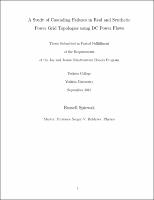Please use this identifier to cite or link to this item:
https://hdl.handle.net/20.500.12202/4206| Title: | A Study of Cascading Failures in Real and Synthetic Power Grid Topologies using DC Power Flows |
| Authors: | Spiewak, Russell |
| Keywords: | Electric power failures --Northwestern States. Failure mode and effects analysis. Electric power-plants --Northwestern States. Electric power systems --Reliability. Electric power systems --Deterioration. Electric power failures --Canada. Electric network topology. Electric power-plants --Canada. Electric power distribution --Research. Communication and traffic --United States. Communication and traffic --Canada. Public utilities. |
| Issue Date: | Sep-2016 |
| Publisher: | Yeshiva College |
| Abstract: | Using the linearized DC power flow model, we study cascading failures and their spatial and temporal properties in the US Western Interconnect (USWI) power grid. We also introduce the preferential Degree And Distance Attachment (DADA) model, with similar degree distributions, resistances, and currents to the USWI. We investigate the behavior of both grids resulting from the failure of a single line. We find that the DADA model and the USWI model react very similarly to that failure, and that their blackout characteristics resemble each other. In many cases, the failure of a single line can cause cascading failures, which impact the entire grid. We characterize the resilience of the grid by three parameters, the most important of which is tolerance α, which is the ratio of the maximal load a line can carry to its initial load. We characterize a blackout by its yield, which we define as the ratio of the final to the initial consumed currents. We find that if α ≥ 2, the probability of a large blackout occurring is very small. By contrast, in a broad range of 1 < α < 2, the initial failure of a single line can result, with a high probability, in cascading failures leading to a massive blackout with final yield less than 80%. The yield has a bimodal distribution typical of a first-order transition, i.e., the failure of a randomly selected line leads either to an insignificant current reduction or to a major blackout. We find that there is a latent period in the development of major blackouts during which few lines are overloaded, and the yield remains high. The duration of this latent period is proportional to the tolerance. The existence of the latent period suggests that intervention during early time steps of a cascade can significantly reduce the risk of a major blackout. |
| Description: | The file is restricted for YU community access only. |
| URI: | https://hdl.handle.net/20.500.12202/4206 https://ezproxy.yu.edu/login?url=https://repository.yu.edu/handle/20.500.12202/4206 |
| Appears in Collections: | Jay and Jeanie Schottenstein Honors Student Theses |
Files in This Item:
| File | Description | Size | Format | |
|---|---|---|---|---|
| Russell-Spiewak.pdf Restricted Access | 900.03 kB | Adobe PDF |  View/Open |
This item is licensed under a Creative Commons License

